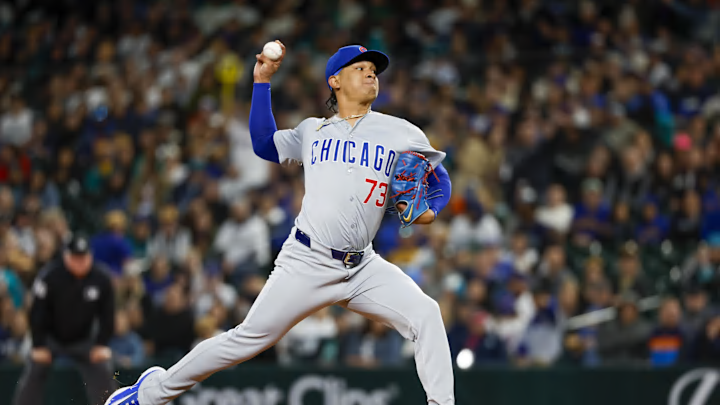The Chicago Cubs are off to a nice start. They began play Sunday morning with a 13-8 record, and in an entirely plausible position to contend for a National League postseason berth.
More impressively, the Cubs have done that despite several debilitating injuries. Their projected pre-season ace, Justin Steele, hasn’t pitched since Opening Day when he left with a strained hamstring. He’s not expected back for another couple of weeks.
The team’s second best-paid pitcher, Jameson Taillon, just returned last week from treatment for a spring training injury. Chicago's cleanup hitter, Seiya Suzuki, is also out until mid-May with an oblique strain.
What the Cubs really need, though, isn’t a healthier starting rotation or lineup – although those would be nice – but a functioning bullpen. As good as that 13-8 record sounds, it doesn’t begin to compare with what the Cubs ought to be doing.
Over the season’s first three weeks, the North Siders have repeatedly fallen victim to the obvious and often fatal flaw in the current system of using pitchers, which amounts to: ‘As hard as possible for as long as possible.’ That governing philosophy, which relies on turning a game over after four, five or at most six innings to a succession of bullpenners, presumes – often wrongly – that each of those relief arms will perform at optimum efficiency.
In effect, around the sixth or seventh inning, what you are watching ceases to be baseball and becomes Russian roulette, the operative question being whether the manager’s next bullpen choice will be the one that kills his team’s chances for victory.
Chicago Cubs' bullpen -- and plan -- is killing them in 2024
In four of their eight losses to date, that’s exactly what has happened to Craig Counsell’s Cubs. In those four games, the Cubs entered the late innings with a lead and at minimum a statistical 80 percent chance to win, yet they lost.
Here are the details of the four games that have taken the Cubs from a potential 17-4 start down to 13-8.
*March 28 (Opening Day). When Ranger reliever Jose Leclerc wild pitched Michael Busch home two outs into the top of the ninth, the Cubs led the Texas Rangers 3-2, giving them an 82 percent shot at victory. But Travis Jankowski opened the bottom of the ninth with a home run off Cubs closer Adbert Alzolay, and Texas walked it off in the 10th.
*April 8. Supporting starter Javier Assad, Cubs hitters constructed an 8-0 lead over the San Diego Padres into the sixth inning. At that point, the odds of a Cub win measured 99 percent, nearly unassailable.
I said nearly. A two-run Jake Cronenworth home run knocked out Assad in the bottom of the sixth, and before the inning was over, the Padres had added five more runs against the Cubs bullpen. A two-out, two-run eighth inning Fernando Tatis Jr. homer off Alzolay was the decisive blow. Final score: Padres 9, Cubs 8.
*April 16. Ian Happ’s seventh inning grand slam gave the Cubs an 11-8 lead against the Arizona Diamondbacks. It also gave Chicago an 87 percent chance of winning the game. But the Diamondbacks pecked away, tying the game on Ketel Marte’s home run off Alzolay with two out in the bottom of the ninth. Arizona won it 12-11 in 10.
*April 20. Alzolay carried a 2-1 lead into the bottom of the ninth against the Miami Marlins at Wrigley Field, and retired the first batter he faced. At that moment, the Cubs had a statistical 92 percent chance of winning. But Luis Arraez singled and Bryan De La Cruz homered into the left field bleachers Miami won 3-2.
The statistics to date condemn Chicago’s bullpen. In 11 save opportunities, they have succeeded five times and blown six, a 45 percent success rate. That’s sixth worst in a league where the MLB average is 61 percent, and where the five teams with worse save percentages are already a combined 48 games under .500.
41 percent of Cubs inherited runners have scored. The MLB average is 35 percent,
Part of the Cubs bullpen’s problem is that Counsell has been forced to use his relievers in pressure situations. On a leverage index scale, where 1.0 equals the MLB average, Cubs relievers have entered the game in situations carrying a leverage index of 1.153, the fourth most pressurized in baseball to date. Having acknowledged that, only Cleveland Guardians pitchers have been summoned more times to protect a lead, and the Guardians pen has a 70 percent save success rate. Beyond that, in all three of the Cleveland pen’s blown saves, the offense rallied to win the game. Chicago’s offense has covered only one of its bullpen’s six mistakes.
Alzolay obviously has been the particular problem. Although he’s only pitched 10 innings, he’s already allowed four home runs, the second highest total on the Cubs staff, and all four of those helped turn near-certain victories into losses.
Last season, by contrast, he pitched 64 innings and only allowed five home runs.
Was Dwight Gooden's 1985 season the best in recent baseball history? (calltothepen.com)
